Whilst at the Department for Work and Pensions, my aim was to understand both citizen and staff pain points across the full end-to-end service and work with the business to come up with opportunities to help citizens get into work.
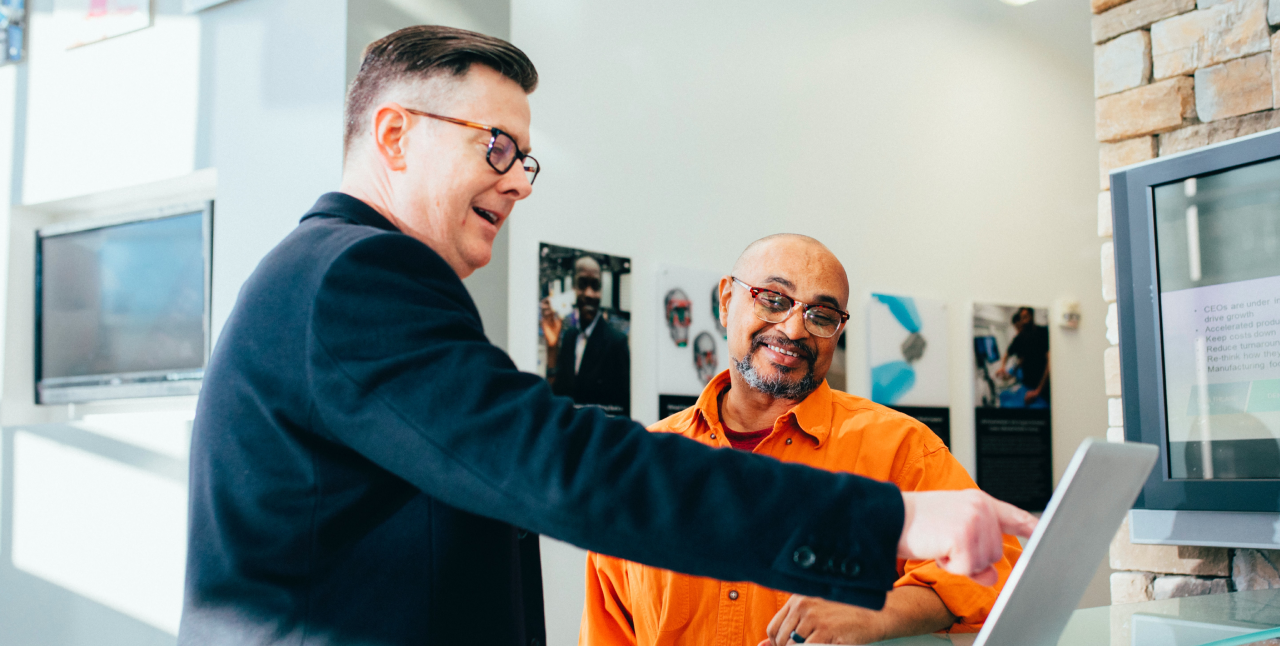
Photo by LinkedIn Sales Solutions on Unsplash
When I joined the Department for Work and Pensions, it was during the COVID-19 pandemic which had led to an unprecedented amount of redundancies and citizens being unable to work. With the Jobseeker's Allowance service being key to providing support to citizens who were out of work, it was crucial to ensure the service was delivering both financial and mentoring support to all citizens in need.
Discovery
Department needs
The Department needed to provide support to more citizens than ever, plus it needed to adapt to all staff now working remotely. To understand more about the issues the service was experiencing, I interviewed those delivering the service and pulled together some recent research conducted with key staff members. This included staff processing applications and payment, support staff answering calls from citizens and work coaches who support citizens in looking for work whilst on the benefit.
I discovered that more staff were needed in the department to process applications and support citizens through regular mentoring. With the job centres closing, staff also needed to have the technology to deliver sessions with at citizens from home. The closure of job centres also meant that the department wasn't able to see citizens and help them apply for the right support and therefore the full application had to be done by the citizens themselves and ID verification had to be done partly via the application and then followed up by a video call with a Department work coach.
The increase of applications, along with citizen's trying to figure out which support to apply for without the help of work coaches, meant that more applications were coming through that needed to be processed. The change in process also meant it was harder for the Department to verify applications effectively and so this meant there could of been ineligible people receiving money from the government.
With a lot of the service now being accessed digitally, this required providing all work coaches having to have sessions with citizens over a video call. For some this was new and took time to work out how to use the technology. For many work coaches the increase in citizens they needed to support meant they could only spend a set amount of time with them.
The challenges of the current economic climate meant there were less jobs available to recommend to citizens to apply for, putting even more pressure on work coaches and the Department needing to support citizens for longer periods of time.
User needs
To understand more about the citizens using the service, I collaborated with a user researcher to speak with them through user interviews. Through a survey, we were able to contact those citizens who said they would be happy to speak to us more about their experience. We spoke to a mix of citizens who were at varying stages of the service, from applying to receiving the benefit and getting back into work.
Once we had conducted our interviews, we started to gather all the insights and pull together key themes.
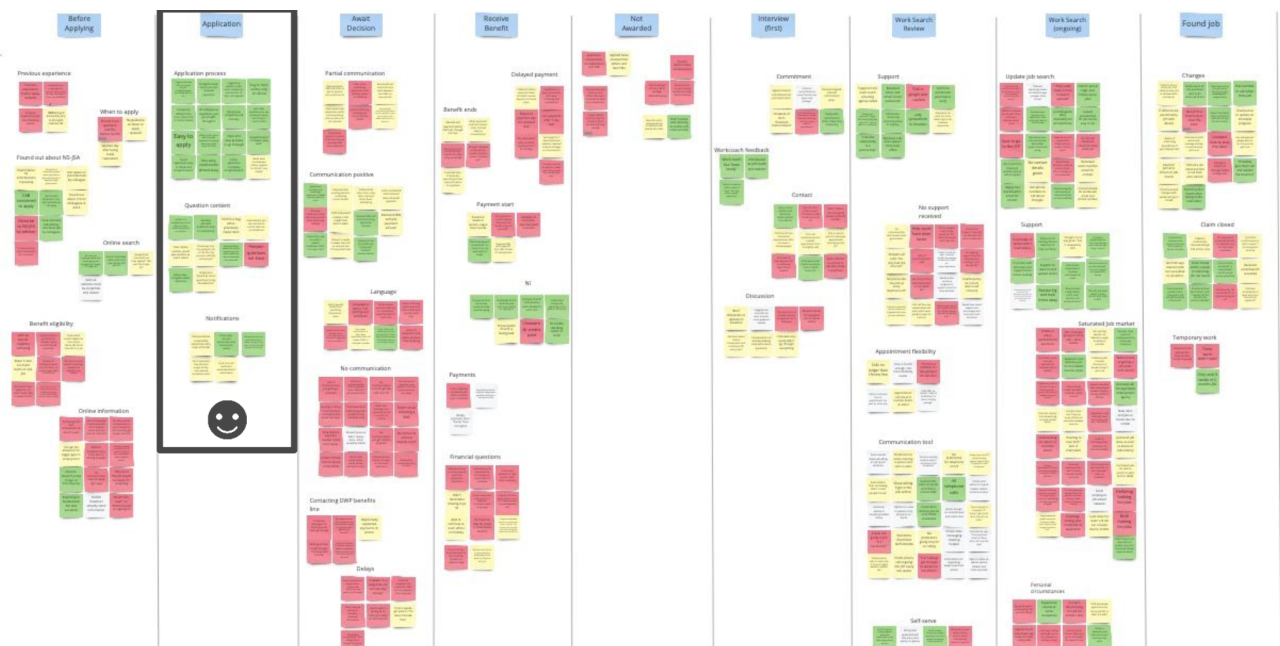
Finding the benefit
Many citizens had experienced issues before even applying for the benefit as they were confused about which benefit to apply for. Although most benefits had been consolidated as part of Universal Credit to make it easy to apply for one thing, the New Jobseekers Allowance hadn't yet been combined. This meant that this benefit was provided to citizens who had enough National Insurance contributions which for most citizens was not clear or well understood.
The application
Apart from a few tricky questions about eligibility, the actual application seemed to be the easiest part of the process. Citizens said most of the questions were simple and the whole application only took 10-20 minutes to complete. With the ease of the application, this gave citizens hope that the whole experience would be like this too. However, waiting for a decision, after applying, became one of the biggest issues for citizens. Citizens expected to hear back within a couple of days, but on some occasions were not hearing back for months. This lead to a huge surge of calls to our call centre from citizens chasing their application and worried about still having no support whilst they were out of work. Due to the confusing eligibility some citizens also received a decision that they couldn't receive the benefit, which was not only frustrating as they waited weeks to hear back, but increased anxiety as there was no information provided for which support they could receive instead, leaving them feeling lost without any financial or general support.
Receiving financial support
When citizens had received a decision that they were eligible for the benefit, they could now expect to receive financial support. Most citizens didn't know when they should expect their first and continual payments and some didn't understand why there was only part of the payment received, which again led to increased calls to the call centre from citizens asking for more clarification. This was even more confusing for citizens who hadn't yet received their decision yet and became concerned that they had received payment wrongly.
Receiving support getting back into work
Another uncertainty for citizens was when and how they would receive support looking for work. With the job centres closed, work coaches were now getting in touch with citizens digitally which for some citizens wasn't that easy. Many missed appointments as they didn't know when their appointments were and/or struggled to connect. Some citizens didn't ever hear from a work coach, even though they had received the payments for months, this was frustrating as they really needed to speak with someone about how to find work.
For those receiving the work coach support, there was still frustrations as the economic climate had caused many citizens to be made redundant from jobs they had been in for years, which meant they lacked confidence to apply for a job in another sector and to even go for an interview.
Many citizens we spoke to were still on the benefit and said they were finding work opportunities through friends, family and colleagues instead of through their work coach. Some citizens we spoke to had found work through their work coach as they had received support from their work coach within a couple of weeks of applying and had received long sessions with their work coach.
Differences in experiences
Through speaking with multiple citizens one of the biggest insights was that all citizens received inconsistent experiences, for example some citizens received payment before a meeting with their work coach and/or receiving a decision. The biggest concern was that some citizens had still not received any verbal communication or support months after applying for the benefit.
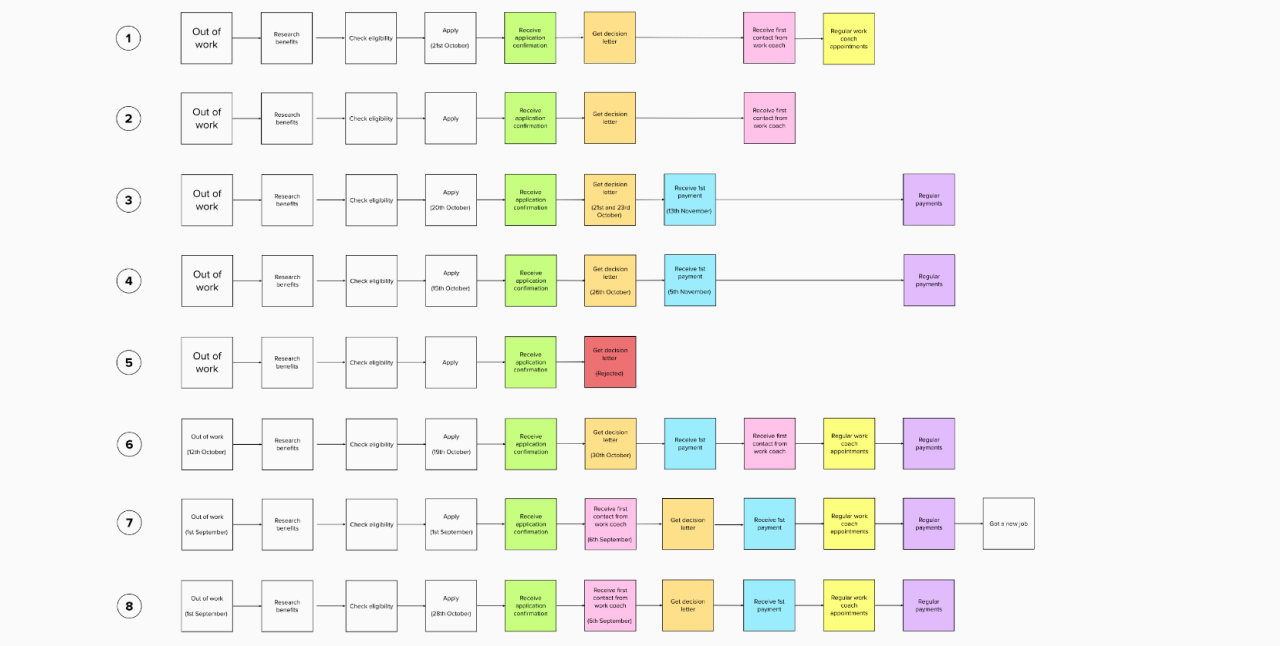
Defining
After gaining insight from both the Department delivering the service and citizens using the service, I started to form the service blueprint, layering in insights to identify route causes of problems, areas for improvement and opportunities to innovate.
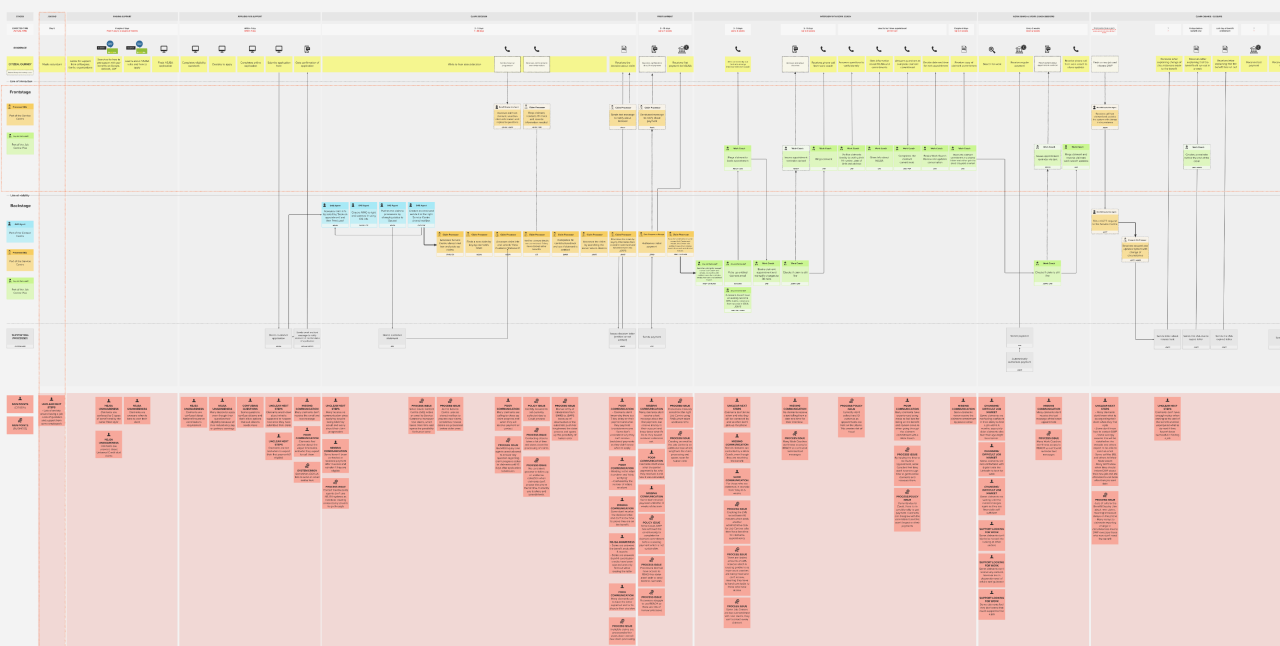
I started with the citizens steps as the top swim lane, followed by swim lanes for all staff involved in delivering the service and more swim lanes for technology and policy that supported the service. Once all the steps for each had been mapped, I started to link interactions.
To help build out processes and technology involved, I had collaborative sessions with BA's and technical architects to run through the draft blueprint and validate and fill in gaps of information. From these sessions, I identified how the service relied upon multiple systems and other government departments, including HMRC, to check eligibility and to get money to citizens. This could sometimes cause delays and complications if information had been inputed incorrectly.
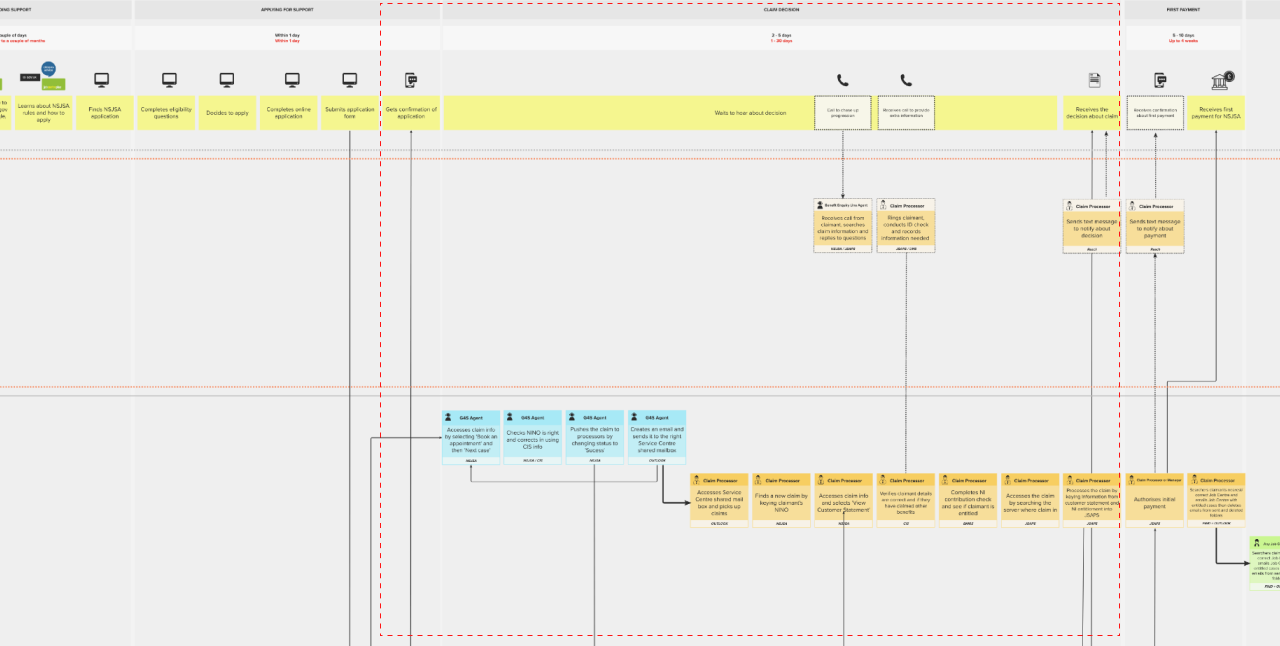
Seeing the full end to end enabled us to see where upstream issues were causing impact further downstream. For example, missing information on the benefit criteria meant that citizens were applying for the wrong benefit, which delayed their application progressing forwards and consequently delaying them receiving support.
The service blueprint also allowed us to dive deep into specific areas and zoom back out again to see the bigger picture. This was key when understanding what was causing delays in citizen's getting their applications processed as we could see all the various touch points the applications were going through behind the scenes and were potential bottlenecks and delays were occurring. This was also crucial in helping us identify reasons for citizens having different experiences, that contradicted the policies and processes defined by the department.
From the service blueprint, we could also see that work coaches were delivering a lot of the service directly to citizens by having regular appointments to help them find work. However, with work coaches working remotely from home, some of them had limited access to systems that they would usually be able to use to help keep records of each citizen. Remote working also meant work coaches had less access to system licences, like SMS services, meaning that work coaches couldn't always send reminder text messages to citizens. Linking this to the citizen experience, many were not having regular sessions due to this missing communication. With a lack of citizen information for work coaches, many citizens felt their sessions weren't great as they had to spend a lot of time re-communicating their circumstances. Overall, we discovered that citizens who received messages, had regular appointments and had work coaches who had access to their records got back into work quicker than those who had the opposite experiences.
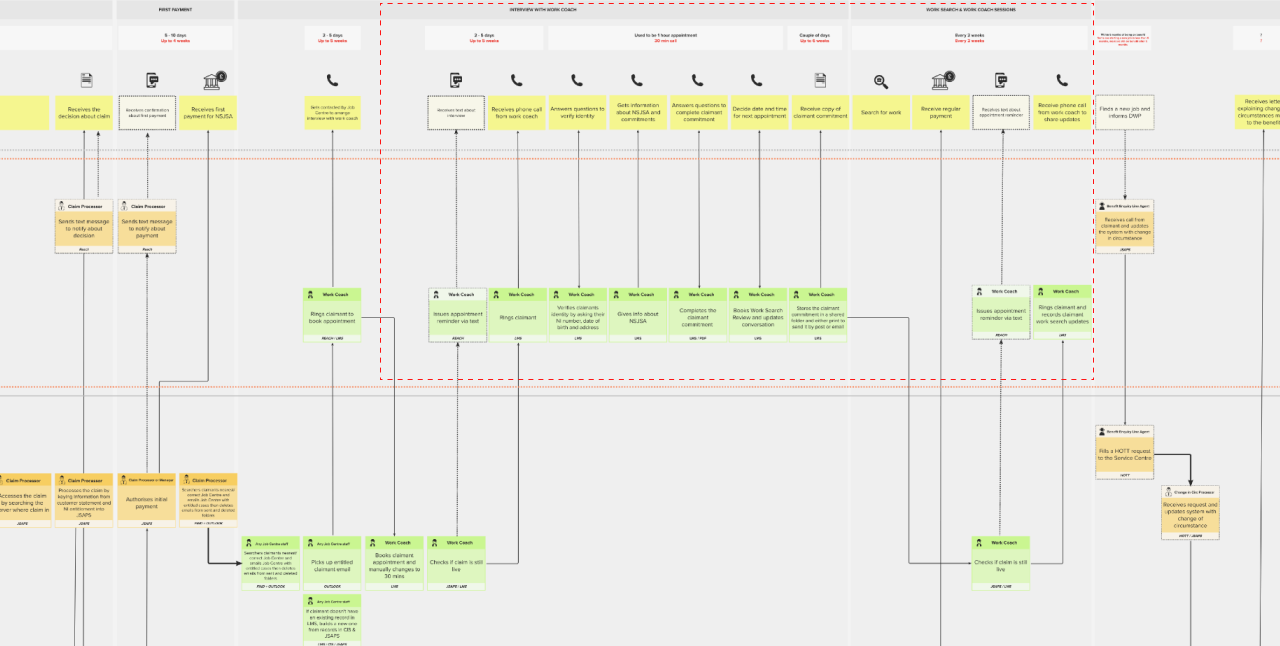
This insight was fed back to the work coach managers, who were not aware of the impact on citizens and as a first improvement, the team worked on providing work coaches with more access to systems to enable them to provide the best service to citizens and ultimately get them back into work as soon as possible.
After building the service blueprint, we played back the full piece to the team and then to stakeholders to help communicate how the service was performing and prioritise where to focus in order to make improvements.
From understanding the full service, we started to work with product to prioritise problems to solve based on citizens impacted and effort to make change. A key area the team decided to focus on first was improving the experience after the application, to ensure citizens were kept in the loop and felt ensured that their application was being processed. For the other areas of pain across the service, we decided to create a prioritised backlog of problems to work through.
To delve into this problem area more, I ran back through all insight and then ran a problem statement workshop with the full service team to define the problem we wanted to tackle first.
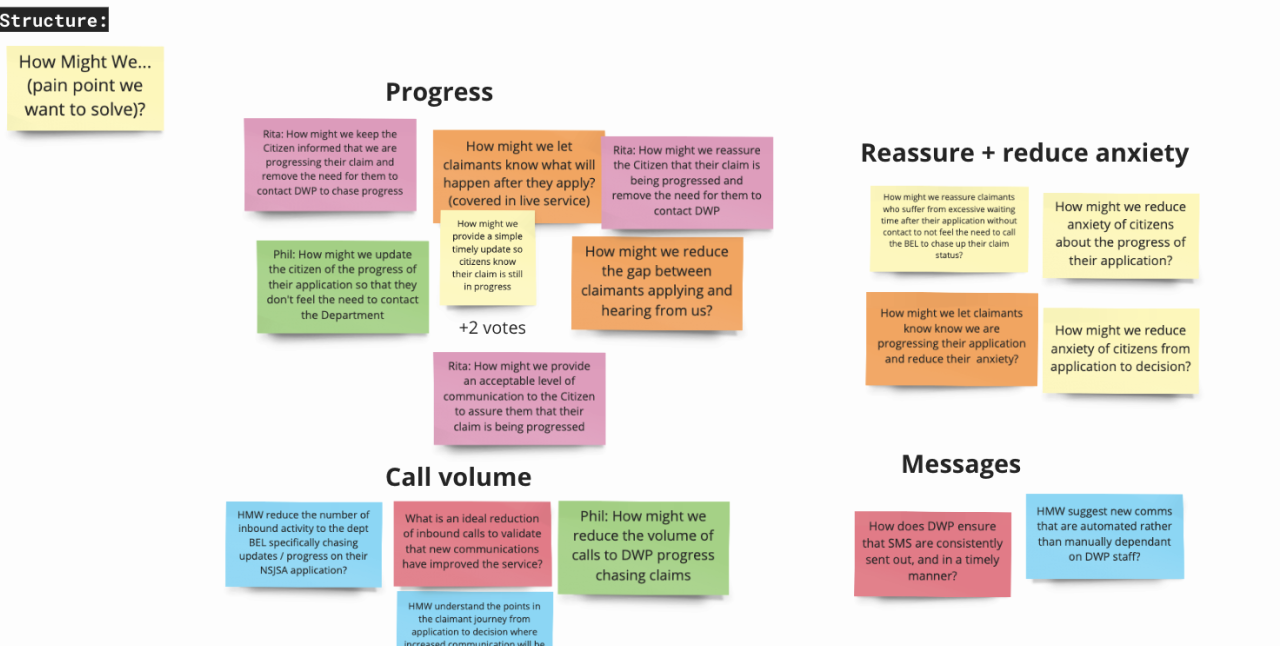
Design
With a problem statement defined, I started to collaborate with the design team to run ideation sessions to come up with possible solutions to solve the problem. With a mixture of disciplines we were able to suggest user focused, technical focused and service focused solutions to help citizens post application experience. Voting as a group on key solutions, the team started to build out winning concepts to test the solution with citizens and staff to understand if they met their needs.
One of the first solutions was to communicate with citizens from post application to receiving their decision, to build reassurance for citizens waiting to hear. To test this concept, the team came up with content of the messages and prepared a mock up flow of the service to replicate. Collaborating with our user researcher and user experience designer we prepared the research sessions and observed how citizens responded. From each research session, we gathered insights and iterated on areas that needed improvement, for example content and tone of voice of the messages.
The design team iterated and re tested with citizens until we were confident to move the concept into delivery. We also provided regular feedback sessions with the team and stakeholders to highlight learnings and gain by in for delivering new designs to the service.
'To be' vision
For the whole service, I started to look at 'to be' solutions for the service areas and mapped out how redesigning the service could help both meet citizen and Department needs better. I started with the citizens experience and mapped out an optimum service for them and then ran through all the various service delivery teams to design how the service would work to deliver this.
For example, a strategic improvement was to reduce the time citizens would get a decision on their application. To do this, I needed to design a service that would reduce the time to process applications, by understanding what was causing the delays in the service. I highlighted that applications should be picked up in date order, so applications could be processed respective of when they came in. I removed duplication of work and multiple teams doing the same activities. And I reduced handovers between departments where applications would be transferred and left in mailboxes until they were picked up.
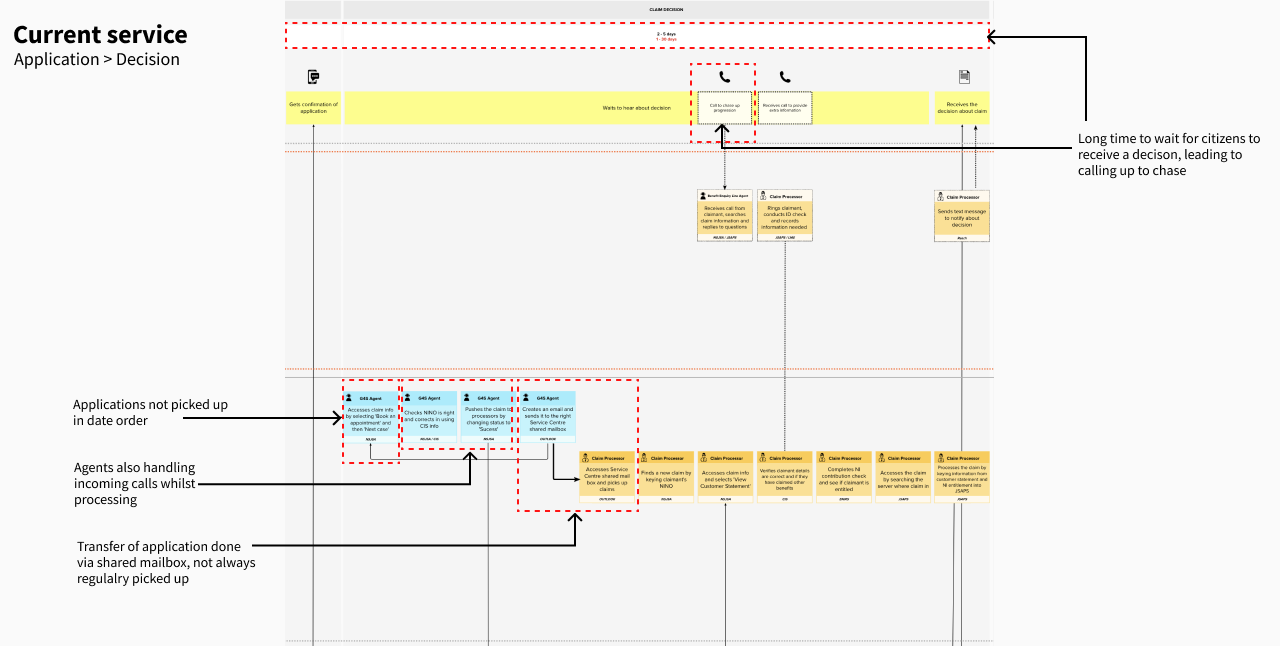
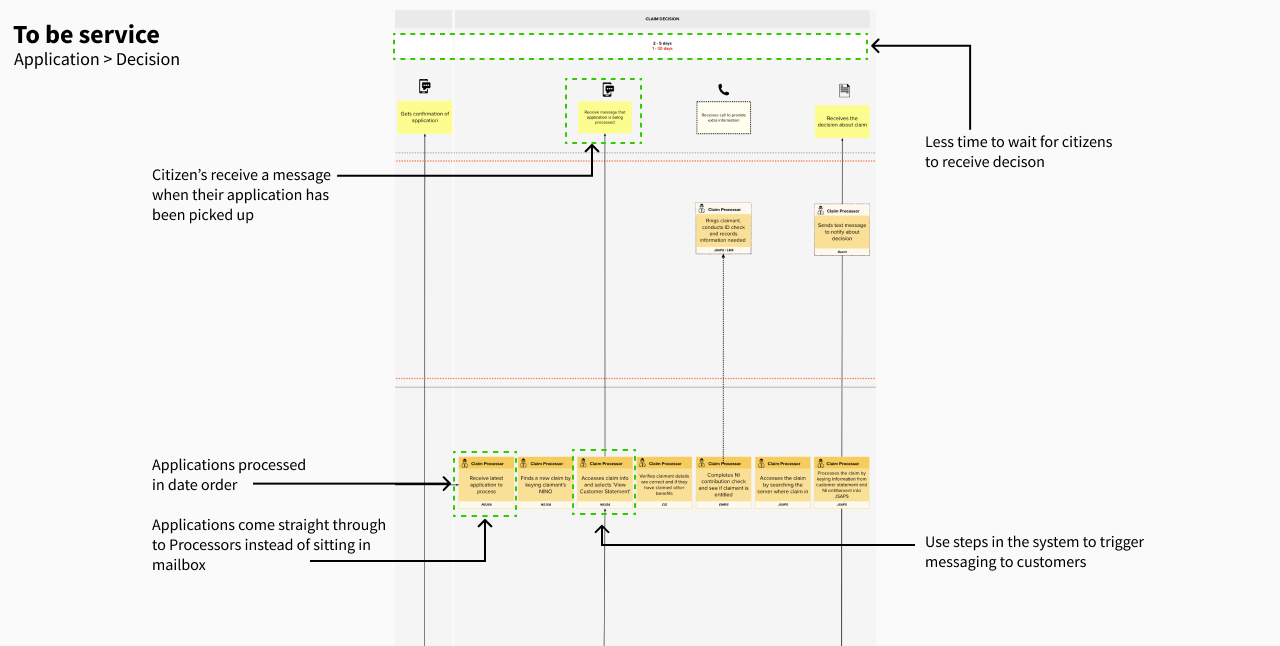
Delivery
Once concepts started to be validated and the team became confident the solutions met citizen needs, I supported the delivery team on redesigning how the service would work. This involved using the service blueprint of the current service, to ensure changes would connect with the existing service. For one of the first solutions, the idea was to communicate more effectively with citizens after they had applied for the service. From a service design perspective, I looked at key opportunities for communication post application and then looked for systems and processes that would enable communication to happen.
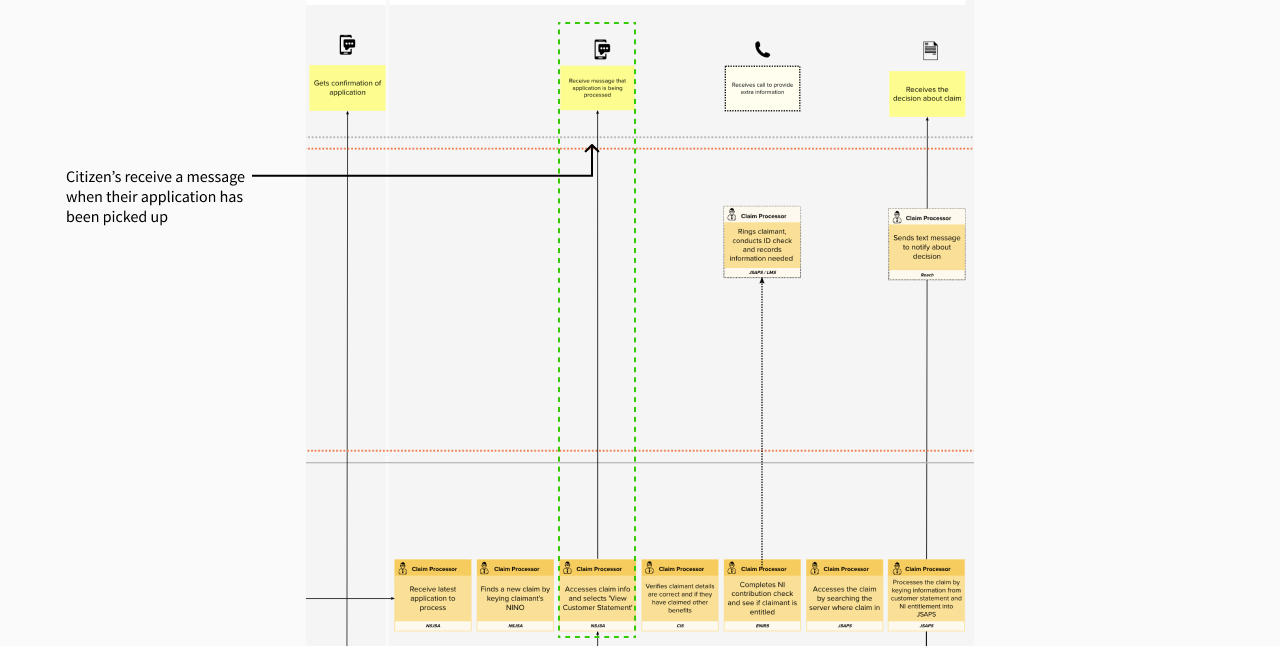
Continuous improvements of the service
To help keep a track of changes, work in progress and our backlog of problems to solve across the service, I created a high level working board of the service with all backlog items across it. This included citizen steps, with all pain points, tickets in flight and opportunities mapped from end to end. This was used in backlog refinement sessions to help give the product manager a good idea of what problems we were currently solving, plus looking forward to problems to solve next.
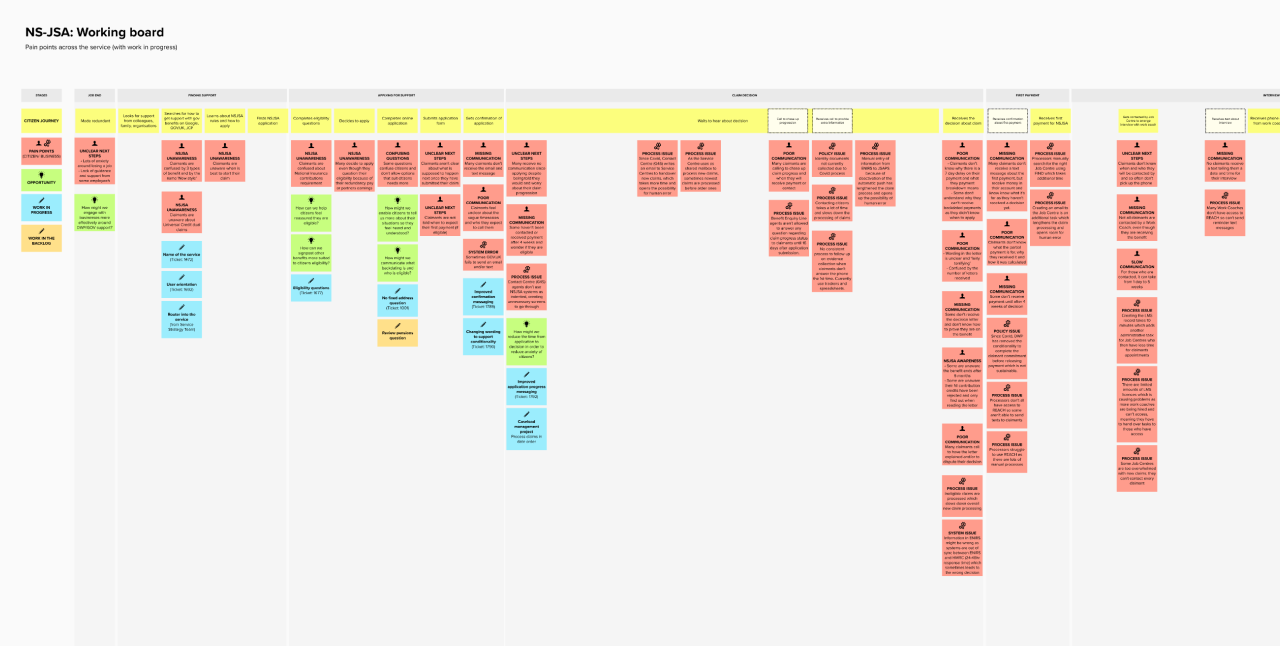
Collaboration across other services
Within the Working Age department of DWP, a lot of the services connected and therefore, I proactively, collaborated with other services to ensure the Jobseekers Allowance effectively linked up. I had regular sessions with other service designers from other services and we would discuss work in progress and current insights we had discovered. We learnt that all services were facing the similar problems, for example, citizens not knowing which benefit to apply for, struggling to navigate the gov.uk website and when receiving negative decision on their application not being signposted to what they could be eligible for.
In order to best address shared issues, we started working groups, shared insights, fed back learnings and helped align service teams to help prioritise and share the work involved in solving problems. This was particularly effective as it helped teams be more efficient and helped our citizens experience a better service. This led into a service strategy piece I started to lead with the head of product which involved aligning all the services involved in helping citizens get back into work.
